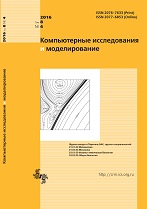|
MATHEMATICAL MODELING AND NUMERICAL SIMULATION
Transition to chaos in the «reaction-diffusion» systems. The simplest models
G. G. Malinetskii, D. S. Faller
Keldysh Institute of Applied Mathematics, 4 Miusskaya sq., Moscow, 125047, Russia
Abstract:
The article discusses the emergence of chaotic attractors in the system of three ordinary differential equations arising in the theory of “reaction-diffusion” systems. The dynamics of the corresponding one- and two-dimensional maps and Lyapunov exponents of such attractors are studied. It is shown that the transition to chaos is in accordance with a non-traditional scenario of repeated birth and disappearance of chaotic regimes, which had been previously studied for one-dimensional maps with a sharp apex and a quadratic minimum. Some characteristic features of the system — zones of bistability and hyperbolicity, the crisis of chaotic attractors — are studied by means of numerical analysis.
Keywords:
nonlinear dynamics, “reaction-diffusion” systems, bifurcation, self-similarity, “cascade of cascades”, attractor crisis, ergodicity, bistability.
Received: 12.11.2013
Revised: 25.12.2013
Citation:
G. G. Malinetskii, D. S. Faller, “Transition to chaos in the «reaction-diffusion» systems. The simplest models”, Computer Research and Modeling, 6:1 (2014), 3–12
Linking options:
https://www.mathnet.ru/eng/crm300 https://www.mathnet.ru/eng/crm/v6/i1/p3
|

| Statistics & downloads: |
| Abstract page: | 152 | | Full-text PDF : | 75 | | References: | 24 |
|




 Contact us:
Contact us: Terms of Use
Terms of Use
 Registration to the website
Registration to the website Logotypes
Logotypes







 Citation in format
Citation in format 